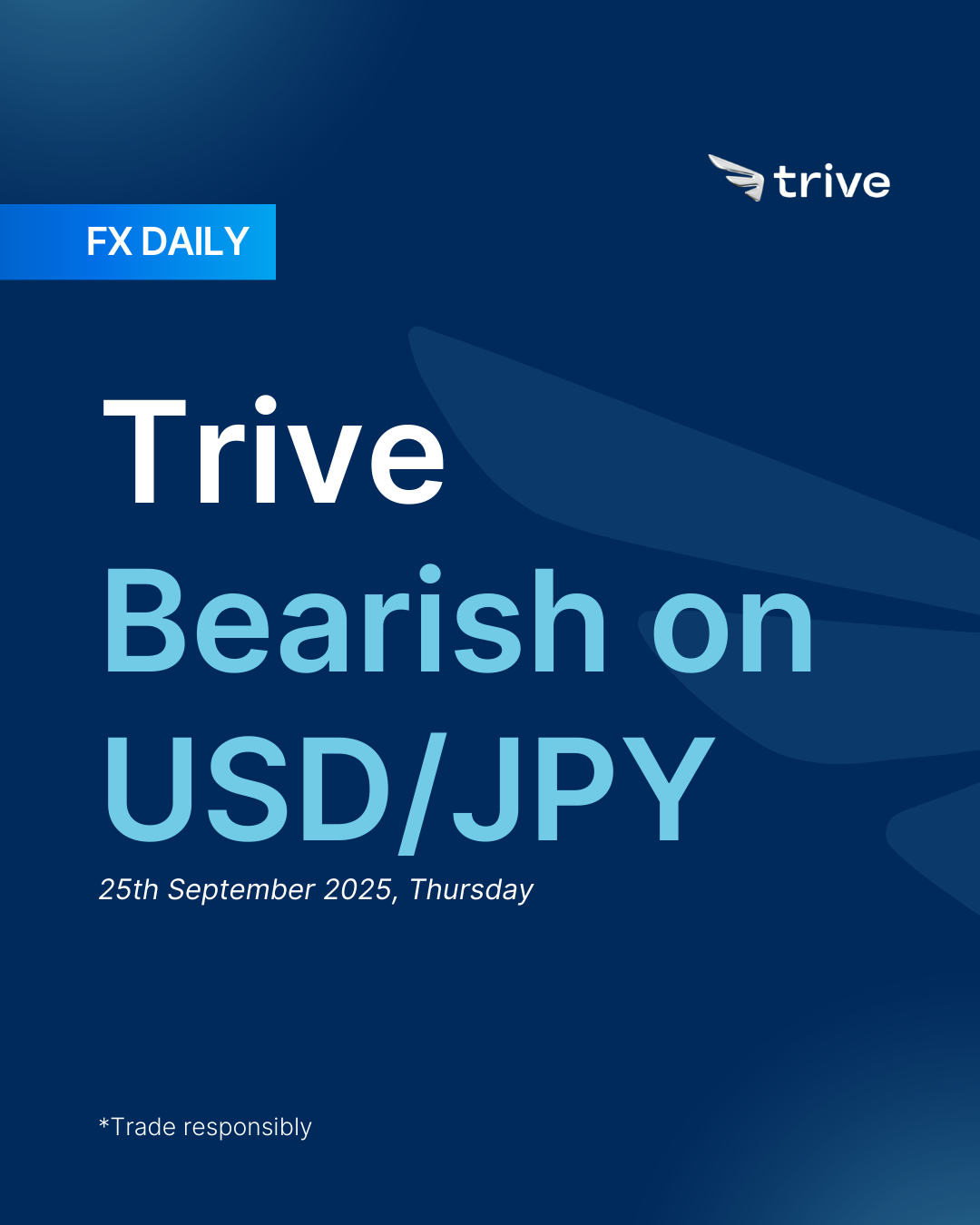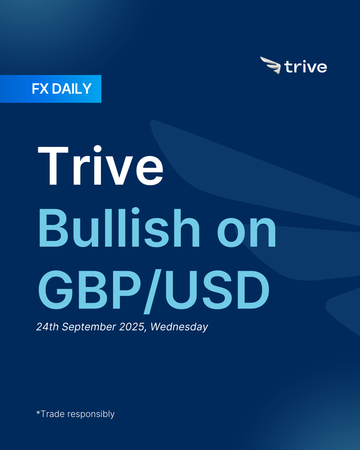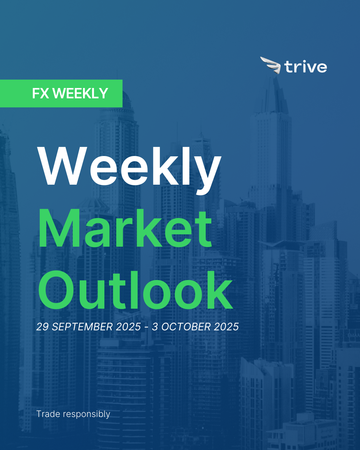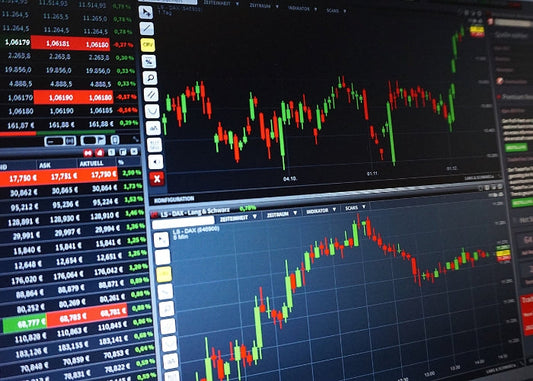FX Daily: Trive Bearish on USD/JPY

The BoJ’s “hawkish hold” — with dissents for a hike and plans to unwind ETF/J-REIT holdings — briefly lifted the yen, but a strong US dollar rebound erased gains, keeping USD/JPY near 148.00. Ueda signaled October remains live, and balance sheet normalization adds credibility to gradual tightening. While near-term flows keep the pair range-bound, spreads are set to compress as Fed easing outpaces BoJ normalization. With Japan’s current account surplus intact and policy risk tilting hawkish, we shift bearish USD/JPY, favoring downside on rallies.
JPY: Short term strength
The Japanese Yen’s week was shaped by a sharp hawkish pivot from the Bank of Japan, though this was ultimately neutralized by a resurgent US Dollar. The Yen started on solid footing, with USD/JPY falling from 148.00 to 146.00, largely due to broad-based dollar weakness and background focus on Japan’s upcoming LDP leadership election. However, the narrative changed completely on Friday after the BoJ delivered what markets called a “hawkish hold.”
While the central bank left its policy rate unchanged as expected, two board members unexpectedly dissented in favor of a 25bps hike, and the BoJ surprised markets by announcing plans to start selling its ETF and J-REIT holdings. This announcement sparked a sharp but temporary rally in the Yen. Governor Ueda reinforced the hawkish message at his press conference, making it clear that the BoJ does not need to wait for the full impact of US tariffs before hiking again, which signaled that an October move is possible. Even with this significant shift, the Yen’s rally could not hold as the powerful post-FOMC dollar rebound took over, leaving USD/JPY to end the week near 148.00 in what became a tug-of-war between two newly hawkish central banks.
The BoJ’s decision to hold rates at 0.50% came with a 7–2 vote, with Takata and Tamura dissenting for an immediate hike. This was the first hawkish dissent of the current cycle and a strong signal of a shifting consensus. The surprise announcement of balance sheet normalization, with annual sales of JPY 330bn in ETFs and JPY 5bn in J-REITs, marked the first step toward quantitative tightening. Governor Ueda’s hawkish press conference fueled speculation of an October hike, with markets now viewing the October 31 decision as a “coin flip” for a 25bps increase.
Economic data took a backseat to BoJ policy signals. Japan’s August trade deficit was smaller than expected, while weaker Machinery Orders and an in-line CPI report had little effect as investors stayed focused on the policy outlook. Domestic politics added some background noise, as fluctuations in the Yen were briefly linked to the LDP leadership race ahead of the October 4 election.
In price action, the Yen strengthened notably against currencies like the euro and pound following the BoJ decision, but USD/JPY told a different story. The pair initially dropped sharply from 148.00 to 147.21 after the announcement, but the move quickly faded as Ueda avoided committing outright to an October hike. The broader dollar rally then reasserted itself, pushing USD/JPY back toward its starting level for the week.
Near term neutral. We keep the stance at neutral. The BoJ’s hawkish hold and balance sheet steps add domestic support, but Goldman’s point about limited risk premium into the October 4 leadership vote and low odds of an October hike argues against chasing yen strength just yet. External drivers still lean against funding FX as a benign US backdrop keeps risk appetite firm, so high beta peers such as AUD and SEK can outperform even if USDJPY stays range bound. Key risks this week are Wednesday’s Flash Manufacturing PMI, BoJ Core CPI, and the BoJ Minutes, followed by Thursday’s Tokyo Core CPI, all of which could quickly tilt front end pricing and the tone.
Longer term weak bullish. Our medium horizon bias is unchanged from last week. Gradual normalization, improving wage and services inflation signals, and the current account surplus remain supportive, while lower hedging costs over time and eventual Fed easing should narrow differentials and favor a stronger yen. We would upgrade if wage gains and core services hold firm alongside clearer BoJ guidance, and temper if the leadership transition delays normalization or a renewed US growth lead lifts global yields. If the driver mix flips meaningfully or if policy guidance shifts more dovishly than expected, we will reconsider and lean toward a weaker currency until the data and pricing improve.
USD: Short at rally
The US Dollar experienced a volatile week that was shaped by a sharp hawkish reversal from the Federal Reserve, later reinforced by strong economic data. The DXY began the week on a soft note, trading below 97.50 as markets anticipated a dovish outcome from the FOMC meeting. The initial reaction to Wednesday’s decision was indeed negative for the dollar. A 25bps rate cut, a dovish dissent for a 50bps cut from new Governor Miran, and updated projections showing a median of two more cuts in 2025 pushed the DXY to a weekly low near 96.22. However, this sentiment was completely reversed during Chair Powell’s notably hawkish press conference. He described the move as a “risk management cut,” dismissed the need to move quickly, and emphasized a meeting-by-meeting, data-dependent approach.
This pivot was validated on Thursday when Initial Jobless Claims dropped sharply and the Philly Fed survey came in much stronger than expected, easing fears of an imminent labor market collapse. The dollar surged in response, broke through 97.50, and ended the week near its highs as traders aggressively repriced Fed expectations in line with Powell’s cautious stance rather than the dovish dot plot.
The FOMC delivered what many described as a “hawkish cut” by lowering the policy rate by 25bps to 4.00–4.25%, which was widely expected. New Governor Stephen Miran dissented in favor of a 50bps cut, while the updated Summary of Economic Projections was initially seen as dovish, showing a total of 75bps in cuts for 2025 instead of the previously forecast 50bps. Powell’s press conference proved to be the decisive moment, as he reinforced that the Fed does not feel pressure to move quickly and framed the decision as a precautionary cut in response to rising labor market risks. Fed speakers later reinforced this cautious tone, with Miran confirming he was the most dovish in the projections while more centrist voices such as Minneapolis Fed President Kashkari supported the cut but only saw two more this year if the data warranted it. Former St. Louis Fed President Bullard also called the decision “good” and said he would not have supported 50bps. Following these developments and Thursday’s data, markets scaled back their easing expectations, with implied cuts by December falling to around 44bps compared to nearly 70bps at the start of the week.
The economic data further supported the dollar. Initial Jobless Claims dropped to 231k from 264k, beating expectations of 240k and easing concerns about the labor market. Manufacturing data showed mixed results, with the NY Fed survey plunging to -8.7 but the Philly Fed index surging to 23.2, its strongest in months. Retail Sales in August were strong, with the control group rising 0.7% compared to the expected 0.4%, signaling continued consumer resilience, while housing remained weak as both starts and permits fell more than expected.
Trade and geopolitics also influenced sentiment. The week ended with a phone call between President Trump and President Xi that both sides described as positive and constructive, with Trump announcing plans to visit China early next year and noting progress on the fentanyl issue. Earlier in the week, US-China trade talks in Madrid were reported to have gone well, with officials mentioning a framework agreement on TikTok. However, tensions rose mid-week after reports that China instructed major tech firms such as Alibaba and ByteDance to stop testing and ordering a specific NVIDIA AI chip, instead pushing them toward domestic alternatives.
Market sentiment shifted dramatically as the week progressed. At the start, the dollar was pressured by expectations of a dovish Fed and an easing cycle. By mid-week, however, Powell’s hawkish message combined with stronger labor market and manufacturing data shifted the narrative to a Fed that is cautiously cutting into a resilient economy. This sharp pivot was clearly dollar-positive and set the tone for the week’s strong rebound.
Near term bearish. Our outlook remains bearish, as Powell’s hawkish press conference and the stronger data rebound did not change the broader picture of a Fed still leaning toward easing. The rise in unemployment to 4.3% and the slide in consumer confidence point to labor risks that dominate the policy path, even if retail sales and PMIs showed resilience. Inflation holding near 3% keeps the Fed cautious, but it is not accelerating enough to force a sustained shift in front-end pricing. Dollar gains may stretch further as markets digest the “hawkish cut,” yet we still view the mix of softer labor and stable risk appetite as favoring renewed weakness rather than lasting strength.
Longer term weak bearish. We keep a gradual softening bias as US outperformance cools and differentials compress, with the Fed’s own projections still pointing to cuts in 2025. Growth is uneven, with consumer spending and services staying firm but housing and labor showing cracks, which argues against a durable turn in favor of the dollar. Reserve status and safe-haven demand can create countertrend support in risk-off episodes, but absent a global shock, the balance of easing and narrowing spreads should cap upside over the medium horizon. If inflation and wages together show a sustained reacceleration, we would tilt stronger, but otherwise the weak bearish outlook stands. If the driver mix flips meaningfully or if policy guidance shifts more dovishly than expected, we will reconsider and lean toward a weaker currency until the data and pricing improve.

Disclaimer
This material is provided for informational purposes only and does not constitute financial, investment, or other advice. The opinions expressed in this material are those of the author and do not necessarily reflect the views of Trive International. No opinion contained in this material constitutes a recommendation by Trive International or its author regarding any particular investment, transaction, or investment strategy. This material should not be relied upon in making any investment decision.
The information provided does not consider the individual investment objectives, financial situation, or needs of any specific investor. Investors should seek independent financial advice tailored to their individual circumstances before making any investment decisions. Trive International shall not be liable for any loss, damage, or injury arising directly or indirectly from the use of this information or from any action or decision taken as a result of using this material.
Trive International may or may not have a financial interest in the companies or securities mentioned. The value of investments may fluctuate, and investors may not get back the amount they originally invested. Past performance is not indicative of future results.
For more information about Trive International, please visit http://trive.com/int
Additional Information
Investing involves risk, including the potential loss of principal. Diversification and asset allocation strategies do not ensure a profit or guarantee against loss. The content in this material is subject to change without notice and may become outdated or inaccurate over time. Trive International does not undertake any obligation to update the information in this material.
By accessing this material, you acknowledge and agree to the terms of this disclaimer. If you do not agree with these terms, please refrain from using this information.
No comments
Home
Trive
TriveHub





0 comments